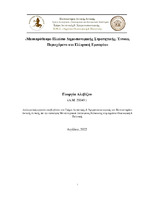| dc.contributor.advisor | Στρόμπλος, Νικόλαος | |
| dc.contributor.author | Αλεβίζου, Γεωργία | |
| dc.date.accessioned | 2022-12-22T09:24:57Z | |
| dc.date.available | 2022-12-22T09:24:57Z | |
| dc.date.issued | 2022-12-14 | |
| dc.identifier.uri | https://polynoe.lib.uniwa.gr/xmlui/handle/11400/3526 | |
| dc.identifier.uri | http://dx.doi.org/10.26265/polynoe-3366 | |
| dc.description.abstract | Μια από τις σημαντικότερες μεταρρυθμιστικές παρεμβάσεις στον εκσυγχρονισμό της διαχείρισης των δημόσιων δαπανών που αποτυπώθηκε στο δημοσιονομικό νόμο 3871/2010 είναι η καθιέρωση της σύνταξης ενός κυλιόμενου Μεσοπρόθεσμου Πλαισίου Δημοσιονομικής Στρατηγικής (ΜΠΔΣ). Το ΜΠΔΣ δίνει μια σαφή εικόνα των δημοσιονομικών ορίων και των δεσμεύσεων που
αναλαμβάνονται για την επόμενη περίοδο, των βασικών πολιτικών κατευθύνσεων και των προτεραιοτήτων. Θέτει συγκεκριμένους στόχους, χρονοδιάγραμμα και δείκτες υλοποίησης στην προσπάθεια ελέγχου των δαπανών και σταδιακής μείωσης του ελλείμματος θέτοντας, παράλληλα, τα ανώτατα όρια δαπανών για όλη την περίοδο για τους φορείς της κεντρικής Κυβέρνησης.
Η παρούσα εργασία έχει ως σκοπό να καταγράψει τις βασικές πτυχές των ΜΠΔΣ που καταρτίστηκαν ως το 2022 και να αξιολογήσει την επιτυχίες και τις αποτυχίες τόσο συνολικά, όσο και στα επιμέρους μεγέθη της ελληνικής οικονομίας. Τελικά θα γίνει μια αποτίμηση κατά πόσο η σύνταξη και η εφαρμογή των ΜΠΔΣ βοήθησε στον μετασχηματισμό της δημοσιονομικής οπτικής και πολιτικής των εκάστοτε κυβερνήσεων. Η υιοθέτηση και εφαρμογή των ΜΠΔΣ υπήρξε μια δομική μεταρρύθμιση, που άλλαξε άρδην
τον τρόπο σχεδιασμού και εφαρμογής της δημοσιονομικής πολιτικής από την Κεντρική Κυβέρνηση και τους φορείς της. Έχει ιδιαίτερη ιστορική σημασία αφενός να καταγραφούν και να αξιολογηθούν ποσοτικά και ποιοτικά τα ΜΠΔΣ και αφετέρου τα συμπεράσματα που θα εξαχθούν να βοηθήσουν σε μελλοντικές συζητήσεις σε σχέση με το πνεύμα και τα μέσα των ΜΠΔΣ. | el |
| dc.format.extent | 101 | el |
| dc.language.iso | el | el |
| dc.publisher | Πανεπιστήμιο Δυτικής Αττικής | el |
| dc.rights | Αναφορά Δημιουργού - Μη Εμπορική Χρήση - Παρόμοια Διανομή 4.0 Διεθνές | * |
| dc.rights | Attribution-NonCommercial-NoDerivatives 4.0 Διεθνές | * |
| dc.rights.uri | http://creativecommons.org/licenses/by-nc-nd/4.0/ | * |
| dc.subject | Μεσοπρόθεσμο δημοσιονομικό πλαίσιο | el |
| dc.subject | Οικονομική διακυβέρνηση | el |
| dc.subject | Δημοσιονομική πειθαρχία | el |
| dc.subject | Δημοσιονομικοί κανόνες | el |
| dc.subject | Οικονομικές κρίσεις | el |
| dc.subject | Εποπτεία | el |
| dc.subject | Προϋπολογισμός | el |
| dc.subject | Δημοσιονομικός σχεδιασμός | el |
| dc.subject | Medium term budgetary framework | el |
| dc.title | Μεσοπρόθεσμο Πλαίσιο Δημοσιονομικής Στρατηγικής (ΜΠΔΣ). Έννοια, περιεχόμενο και ελληνική εμπειρία | el |
| dc.title.alternative | Medium Term Budgetary Framework. Definition, content and the greek case analysis | el |
| dc.type | Μεταπτυχιακή διπλωματική εργασία | el |
| dc.contributor.committee | Πανάγου, Βασίλειος | |
| dc.contributor.committee | Chalikias, Miltiadis | |
| dc.contributor.faculty | Σχολή Διοικητικών, Οικονομικών & Κοινωνικών Επιστημών | el |
| dc.contributor.department | Τμήμα Λογιστικής και Χρηματοοικονομικής | el |
| dc.contributor.master | Δημόσια Οικονομική και Πολιτική | el |
| dc.description.abstracttranslated | One of the most important reform interventions in the modernization of public expenditure management reflected in the fiscal law 3871/2010 was the establishment of the drafting of a rolling Medium Term Budgetary Framework (MTBF). The MTBF gives a clear picture of the budgetary limits and commitments undertaken for the next period, the main political directions and priorities. It sets specific goals, timetables and implementation indicators in the effort to control expenses and gradually reduce the deficit while setting, at the same time, the upper limits of expenses for the entire period for the agencies of the central Government. The purpose of this paper is to record the main aspects of the MTBFs drawn up until 2022 and to evaluate the successes and failures both overall and in the individual sizes of the Greek economy. Finally, an assessment will be made as to whether the drafting and implementation of the MTBFs helped to transform the fiscal perspective and policy of the respective governments. The adoption and implementation of the MTBFs was a structural reform, which changed the way fiscal policy was planned and implemented by the Central Government and its agencies. It is of particular historical importance on the one hand to record and quantitatively and qualitatively evaluate the IPAs and on the other hand the conclusions that will help in future discussions regarding the spirit and means of the MTBFs. | el |


